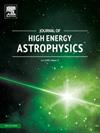Dynamics of an interacting matter − f(R) model with expansion histories approximating ΛCDM
IF 10.5
4区 物理与天体物理
Q1 ASTRONOMY & ASTROPHYSICS
引用次数: 0
Abstract
The paper examines the cosmological dynamics of a model that integrates interactions between matter and an effective fluid. It employs a dynamical system approach with three cosmographic parameters. The equilibrium state's physical characteristics and linear stability within the cosmological dynamical system, derived from the field equations, are examined, taking into account an interacting term and the specific relationships among cosmological parameters as per ΛCDM cosmology. It is found that the solutions of the model, while imposing a global ΛCDM alike evolution, exhibit significant sensitivity to initial conditions when evaluating cosmological parameters, primarily due to the phase-space constraints imposed by the viability conditions for models. The presence of the interacting term alters most equilibrium points in the system and contributes to the cosmological evolution, imposing constraints on the parameter α of interaction strength. Additionally, by using Poincaré compactification, we conduct a global dynamics analysis for the spatially flat scenario, revealing all possible evolutions of the flat universe in the form of a Poincaré disk and a comprehensive dynamic flow chart. Several equilibrium points and the cosmological evolution within this model exhibit slight deviations from the non-interacting case, yet it successfully captures the universe's acceleration phase.
膨胀历史近似ΛCDM的相互作用物质- f(R)模型动力学
本文研究了一个f(R)模型的宇宙学动力学,该模型集成了物质和有效流体之间的相互作用。它采用具有三个宇宙学参数的动力系统方法。考虑到相互作用项Q=3α ρ和ΛCDM宇宙学中宇宙学参数之间的具体关系,从场方程推导出的宇宙学动力系统中平衡态的物理特性和线性稳定性。研究发现,该模型的解在施加全局ΛCDM相似演化的同时,在评估宇宙学参数时表现出对初始条件的显著敏感性,这主要是由于f(R)模型的生存条件所施加的相空间约束。相互作用项的存在改变了系统中的大部分平衡点,促进了宇宙演化,并对相互作用强度参数α施加了约束。此外,通过使用庞卡罗莱紧化,我们对空间平坦情景进行了全局动力学分析,揭示了平坦宇宙以庞卡罗莱莱盘和综合动态流程图的形式的所有可能的演化。该模型中的几个平衡点和宇宙演化与非相互作用情况略有偏差,但它成功地捕获了宇宙的加速阶段。
本文章由计算机程序翻译,如有差异,请以英文原文为准。
求助全文
约1分钟内获得全文
求助全文
来源期刊

Journal of High Energy Astrophysics
Earth and Planetary Sciences-Space and Planetary Science
CiteScore
9.70
自引率
5.30%
发文量
38
审稿时长
65 days
期刊介绍:
The journal welcomes manuscripts on theoretical models, simulations, and observations of highly energetic astrophysical objects both in our Galaxy and beyond. Among those, black holes at all scales, neutron stars, pulsars and their nebula, binaries, novae and supernovae, their remnants, active galaxies, and clusters are just a few examples. The journal will consider research across the whole electromagnetic spectrum, as well as research using various messengers, such as gravitational waves or neutrinos. Effects of high-energy phenomena on cosmology and star-formation, results from dedicated surveys expanding the knowledge of extreme environments, and astrophysical implications of dark matter are also welcomed topics.
 求助内容:
求助内容: 应助结果提醒方式:
应助结果提醒方式:


